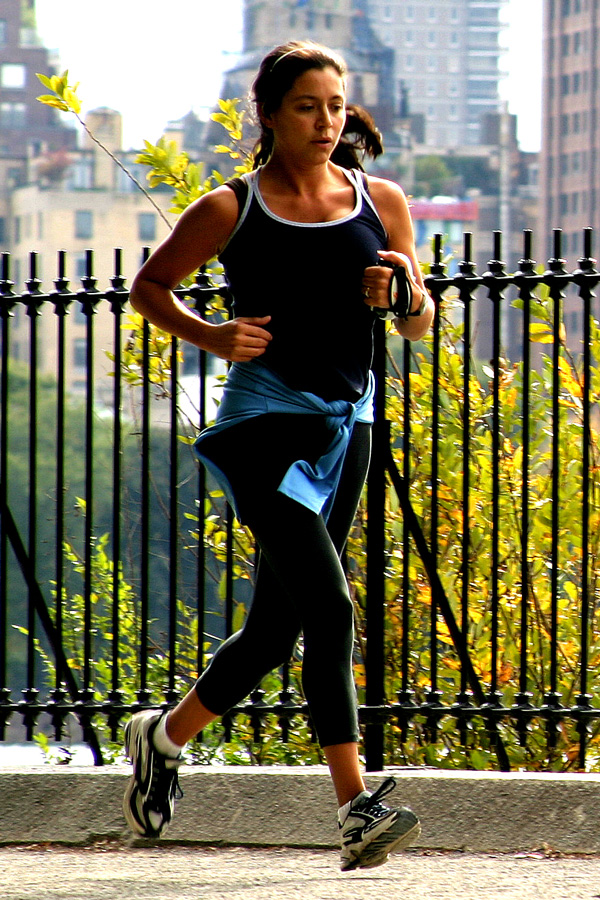
Thomas Hawk via Flickr (CC BY-NC 2.0)


As outdoor joggers hit the paths, it's a good time to do some spring cleaning for bad habits that can hobble your running regime.
Running is a great way to exercise the heart, boost mental health and make new friends, says Blair Shular, a physiotherapist with the University of Alberta. "If you look at running groups, there's an informal social aspect that goes along with getting some exercise, with a shared interest of trying to get in shape."
But it's likely that there will be some aches and pains along the way.
"About 80 per cent of runners will experience some form of pain or injury in a calendar year," says Shular, who offered a few tips on how to stay on the right path.
Go with the flow
Should you change how you run? No, says Shular, who analyzes gait through the Glen Sather Sports Medicine Clinic and the Faculty of Rehabilitation Medicine.
"The scientific literature shows that when we try to change our running form, we are eight per cent less efficient, even when trying something simple like changing the number of times your foot hits the ground."
There hasn't been a study that proves that changing gait improves performance or prevents injuries, he adds.
"We run the way we run because it is the most efficient for who we are at the time, and as we get better at running, we will become more economical."
The average recreational runner's foot hits the ground 80 times a minute, compared to an Olympian running the same distance race, whose rate is 90 times per minute.
"If the recreational runner tries to shorten their stride to run at 90 steps per minute, they will tire more quickly, and there's no scientific proof that the trade-off will be fewer injuries," he says.
The only exception to the rule is if you run on your toes - a minimalist trend that has gained ground in recent years, Shular says. "I encourage people to run heel to toe." Running on the toes has been shown to cause stress fractures to the bones in the feet, shin splints (pain in the muscle behind the shin) and achilles tendonitis (pain above the heel).
Don't overdo it
Excessive training, either by increasing distance or speed, can cause running injuries like shin splints, patello-femoral syndrome or runner's knee (a common term for pain under the kneecap), hamstring strains at the back of the leg, and tendonitis, which can cause pain below the knee, above the heel and in the side of the thigh.
Shular suggests using a run/walk program that allows for intermittent breaks. Running for 10 minutes and walking for one minute is a good place to start. "It gives recreational runners a forced rest and allows for some muscle recovery."
Change your shoes
Studies have shown that people who slip on a different pair of shoes for every other run tend to have fewer injuries.
"Our bodies don't fall into the same running pattern all the time, there's always a microchange to our gait when we change our shoes, and that difference is enough for most people to prevent them from having injuries," explains Shular.
Wear out one pair of running shoes to no more than the halfway mark before adding in a new pair, he suggests.
Keep an even keel
Avoid too much hill work when running, as it can cause runner's knee.
"There is a huge increase in compression behind the kneecap when going up and down hills, so too much running on stairs or in uneven terrain leaves you vulnerable to injury."
Mix it up
Add some yoga, weight-training or other physical activity into your fitness routine to decrease the chance of injury.
"Doing other exercises strengthens and stretches different muscles and prevents them from being overused."
End - don't start - with a stretch
Stretching before a long-distance run isn't a good idea, Shular says. "Multiple studies have shown that runners who passively stretch before they run have more muscle and/or tendon injuries." Save it for the end of the run, instead, to prevent muscle imbalances from occurring.
Learn More
Whether you're a recreational player, a varsity athlete, or you just love to exercise and stay active, the Glen Sather Sports Medicine Clinic at UAlberta's Faculty of Rehabilitation Medicine offers a variety of services to the public.
Comment Policy
We at Thought Box welcome your comments. Robust debate and criticism are encouraged, provided it is respectful. We reserve the right to reject comments, images or links that attack ethnicity, nationality, religion, gender or sexual orientation; that include offensive language, threats, spam; are fraudulent or defamatory; infringe on copyright or trademarks; and that just generally aren't very nice. Discussion is monitored and violation of these guidelines will result in comments being disabled.
We at New Trail welcome your comments. Robust debate and criticism are encouraged, provided it is respectful. We reserve the right to reject comments, images or links that attack ethnicity, nationality, religion, gender or sexual orientation; that include offensive language, threats, spam; are fraudulent or defamatory; infringe on copyright or trademarks; and that just generally aren’t very nice. Discussion is monitored and violation of these guidelines will result in comments being disabled.